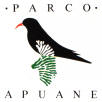|
|
|
|
|
|
|

|
34th
EGN
Coordination Committee Meeting
Wernigerode (Germany),
2nd-5th September 2014 |
|
|
|
|
|
|
|
PHOTO CHRONICLE |
|
|
|
|
|
|
|
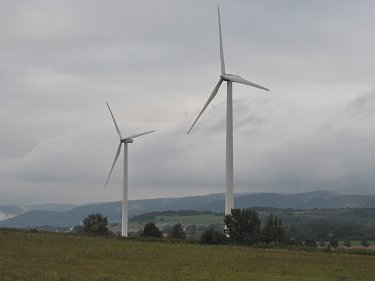
|
Tuesday 02.09.2014
The 34th
EGN Coordination Committee will be held in the old town of Wernigerode
(Saxony) in the Geopark Harz.
Braunschweiger Land. Ostfalen.
From Hanover Airport, the about two hours drive transfer takes place
under a gray sky; The higher mountains of the Geopark (Harz Mountain)
are masked by a thick blanket of clouds; in the foreground wind turbines
that are massively present in this area of German plain. |
|
|

|
Tuesday 02.09.2014
Still a cloudy sky on arrival at Wernigerode, dominated by the castle:
an ancient medieval fortress that was rebuilt and restored in 1700-1800
after the almost total destruction occurred during the 30 Years War
(1618-1648). |
|
|
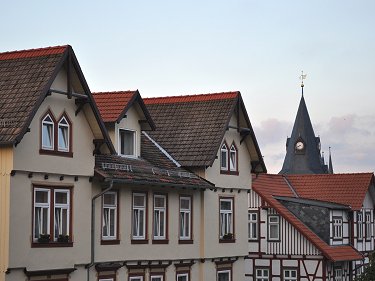
|
Tuesday 02.09.2014
On
arrival, it is immediately evident the typical architecture of the town
of Wernigerode that characterizes both civilian and religious buildings
(in the background the church tower), built in their current form since
1700.
|
|
|

|
Wednesday 03.09.2014
The
34th
EGN
Coordination
Committee
was held
in the Town Hall of
Wernigerode
in the typical
market square. |
|
|
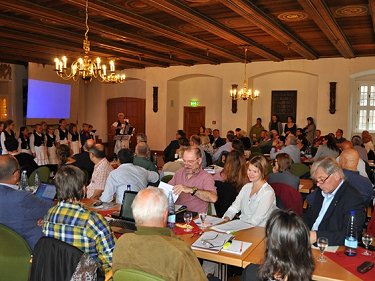
|
Wednesday 03.09.2014
To welcome
in the
conference room,
the representatives of the
60
Geoparks
members
of the EGN
were the
children of the
town
with
popular songs
of the
Harz region. |
|
|

|
Wednesday 03.09.2014
At the table
of the 34th
EGN
Coordination
Committee, from left:
Kristin
Rangnes,
Nickolas
Zouros,
the mayor of
Wernigerode
Gaffert
Peter
and
Patrick
McKeever. |
|
|
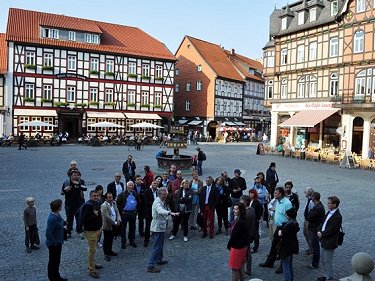
|
Wednesday 03.09.2014
In the late afternoon,
the delegates of
Geoparks,
divided into two groups,
were accompanied by
local guides
along a
city route
to the discovery
of the architecture
and the use
of local
geomaterials
for construction. |
|
|

|
Wednesday 03.09.2014
Along the way,
the
favorable light
and the blue sky
made it possible to
appreciate the
beauty
of the Wernigerode castle. |
|
|

|
Wednesday 03.09.2014
At the end
of the itinerary,
in the great hall
of the
Fürstlicher
Marstall,
was presented
a movie
about the main
emergencies
of geodiversity
in the Geopark
Harz.
Braunschweiger
Land.
Ostfalen.
After
the welcome address
by the President
of the
Geopark,
Tamara Zieschang,
State Secretary of
the Ministry of
Science
and Economics
of Saxony-Anhalt
and
Lutz
Moller,
from the German
UNESCO
Commission,
have intervened. |
|
|
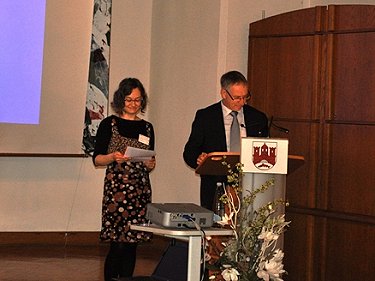
|
Thursday 04.09.2014
Isabel Reuter and George Klaus, on behalf of the organizers, closed
meeting in the Town Hall of Wernigerode. The meeting continued on the
field with visits to other representative sites of the Geopark Harz-Braunschweiger
Land-Ostfalen. |
|
|

|
Thursday 04.09.2014
In the afternoon, the Coordination Committee visited the Paläon, a
futuristic structure built near the archaeological site of Schöningen,
north of Wernigerode, a place famous throughout the world for the
discovery of wooden spears dating back to about 300,000 years ago, then
the oldest hunting tools discovered so far. The Paläon is not only a
museum but also a centre of archaeological research and teaching. |
|
|
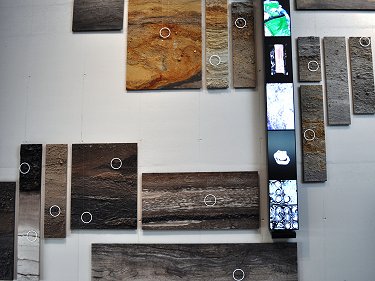
|
Thursday 04.09.2014
When
"geology" can become "art": in the great hall of the Paläon, visitors
are greeted by large panels with natural sections of Quaternary soils
and rocks where remains of Neanderthal man and its artifacts, and
skeletons of many other animals that lived in the Lower Paleolithic
interglacial periods were found. |
|
|

|
Thursday 04.09.2014
One
of the modern exhibits of the Paläon is dedicated to the findings of
skull, tusk and other bones attributed to a mammoth. |
|
|
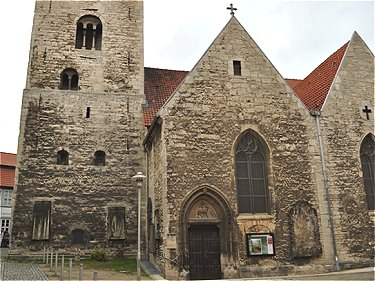
|
Thursday 04.09.2014
The
excursion continued in the town of Koenigslutter where, near the church
dedicated to St. Sebastian, has established an information centre of the
Geopark Harz-Braunschweiger Land-Ostfalen. In the building of the
church is evident the use of rocks that characterize the geology of the
surrounding area: this is the limestone layers rich in fossils of
bivalves, brachiopods, crinoids, ammonites, belonging to the formation
known as Muschelkalk attributed to the Triassic (240-230 million years). |
|
|

|
Thursday 04.09.2014
Inside the information center has been set up a museum about the
geological history of the region. Among the well-preserved fossil
specimens, a stromatolitic limestone. Stromatolites are finely laminated
carbonate bodies, accumulated for the activity of photosynthetic
microorganisms (algae or bacteria) in tropical marine environments,
which can develop domal or columnar morphologies. These fossils are of
particular importance because the term "stromatolite" is derived from
outcrops near Jerxheim in the territory of the Geopark Harz-Braunschweiger
Land-Ostfalen. |
|
|
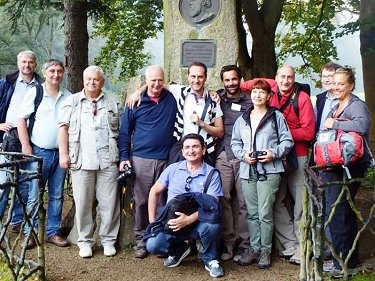
|
Friday 05.09.2014
The excursion within the hosting Geopark took place in the Harz region.
The first, emblematic, stop was at a "rare" monument as it is dedicated
to a geologist: Karl August Lossen (1841-1893). As an employee of the
Prussian Geological Survey and professor of the Royal Mining Academy of
Berlin carried out fundamental geological researches in the area. |
|
|

|
Friday 05.09.2014
The different rocks forming the monument represent the different
granitoid lithologies (biotite granites, diorites, etc.) that
characterize the Harz region.
|
|
|
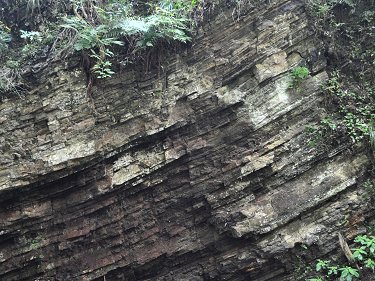
|
Friday 05.09.2014
From
the Lossen Memorial starts a footpath in the mining area of the
Thumkuhlen valley that, especially in 1600-1700, was excavated for
cobalt ore for the production of blue colouring substances. Along the
creek incision, Upper Devonian rocks crop out. They are limestone
turbidites resulting from the erosion of coral reefs formed in marine
environments with warm and shallow waters... in the Palaeozoic, the
climate of the Harz mountains had to be very different from now!
|
|
|

|
Friday 05.09.2014
The partecipants of the meeting near the entrance to the Büchenberg's
mine. They are easily recognizable, even from behind.
|
|
|
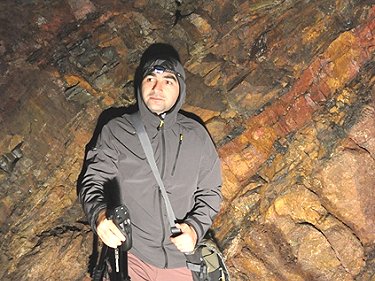
|
Friday 05.09.2014
Inside the mine,
the representatives of the EGN Geoparks particularly appreciated the
outcrops of slates and volcanic rocks (metabasalts) of Middle Devonian
with iron ore (mainly hematite, subordinately magnetite and siderite)
that, folded by tectonics, form a natural tunnel. In the picture, the
reference scale is provided by Erdal Gümüş coordinator of the Kula
Volcanic Geopark, the first and so far only Turkish EGN Geopark.
|
|
|
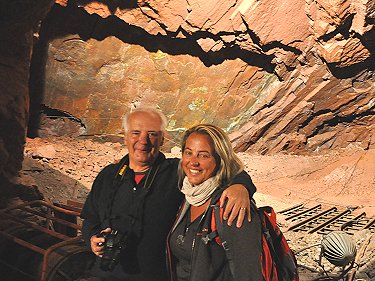
|
Friday 05.09.2014
During the excursion, Tony Ramsay, catalyst of the working group about
the use of waste material from legal mining/quarrying, warmly thanked
the "Apuan guys" for their contribution within the group. This
certificate of excellence was sealed by an embrace with Alessia Amorfini
from Apuan Alps Geopark, inside the Büchenberg mine, not surprisingly in
front of rocky waste from the mine processing.
|
|
|
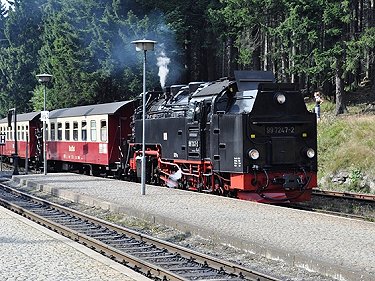
|
Friday 05.09.2014
The workshop of the Italian Geoparks organized by the Apuan Alps has
made ... school!
Even the organizers of the excursion in the Harz region have planned a
train ride, using the railway line with steam locomotive and vintage
wagons to reach Brochen, the highest point of the Harz mountains.
|
|
|
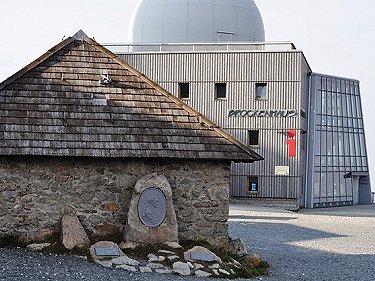
|
Friday 05.09.2014
An
outstanding person in the European culture establishes a link between
the Geopark Harz. Braunschweiger Land. Ostfalen and Italy. He is
Johann Wolfgang Goethe, considered the greatest German intellectual of
all time: poet, scientist, art critic, politician, philosopher. His
famous journey to Italy, from Alps to Sicily, in 1786 led him to tell
not only the culture but also the nature and the landscape of our
country with particular words of interest and admiration towards the
Apennines.
In the picture, the small monument to Goethe at the summit of the
Brocken Mountain; in the background the Geopark visitor centre built in
the former observation station of the German Democratic Republic.
|
|
|
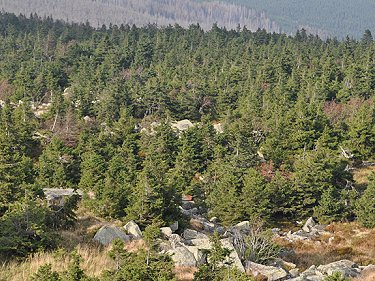
|
Friday 05.09.2014
Even
the geology and landscape of the Harz mountains became known after the
descriptions that Goethe wrote as a result of two trips made in 1777 and
in 1783 looking for personal inspiration and during which he realized
the winter ascent of the Brocken Mountain, the mountain that popular
tradition connects with legends of devils and witches. The experience in
the Harz mountains was reversed by Goethe in Faust, his famous dramatic
poem.
|
|
|

|
Friday 05.09.2014
Inside the Geopark visitor centre, some rooms are devoted to the
geological evolution of the Harz region.
At the center of the picture several specimens of fossil trunks. |
|
|

|
Friday 05.09.2014
From
the geological point of view, a possible correlation between the Harz
mountains and the Apuan Alps can be also considered. Both mountains are
characterized by a geological structure represented by an antiform of
comparable size, but exhumed at different times, Harz from the
Cretaceous, while the Apuan Alps from the Miocene, some million years
later. The Harz mountains are therefore greatly eroded, reaching the
maximum altitude of 1114 m at the Brocken Mountain, and with a landscape
much less harsh than the Apuan Alps. The rocks that form the Harz
antiform belong to the Paleozoic (Devonian-Carboniferous slates,
quartzites and sandstones) with the core made of Permian granites that
constitute the reliefs of the Brocken Mountain (see picture). |
|
|
|
|
|
|
 back to
meeting main page
back to
meeting main page |
|
|
|
|
|
|
|


























